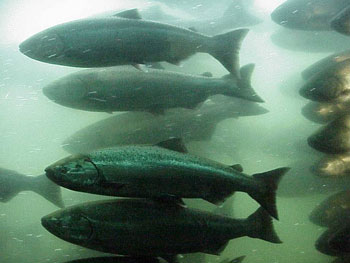Anadromous Fish Agreement and
Habitat Conservation Plan (HCP)
The Douglas PUD worked cooperatively with
various state and federal fisheries agencies, including
National Marine Fisheries Service (NMFS), United States Fish
and Wildlife Service (USFWS), Washington Department of Fish
and Wildlife (WDFW), the Confederated Tribes of the Colville
Reservation, the Confederated Tribes and Bands of the Yakama
Nation and the Confederated Tribes of the Umatilla
Indian Reservation and an environmental organization,
American Rivers, to develop the first hydropower Habitat
Conservation Plan for anadromous salmon and steelhead. The
plan commits Douglas PUD to a 50-year program to ensure that
its hydro project has no net impact on mid-Columbia salmon
and steelhead runs. This will be accomplished through a
combination of juvenile and adult fish passage measures at
the dam, off-site hatchery programs and evaluations, and
habitat restoration work conducted in tributary streams
upstream of Wells Dam. 
As of April 2005, the Wells HCP has been
signed by NMFS, USFWS, WDFW, the Confederated Tribes of the
Colville Reservation, the Confederated Tribes and Bands of
the Yakama Nation, Douglas PUD and the Wells Project
Power Purchasers (Puget Sound Energy, Portland General
Electric, PacifiCorp and Avista Corporation). The Wells HCP
was reviewed and approved by NMFS following the
issuance of biological opinions and Incidental Take Permits
covering hatchery and hydro operation. The Federal Energy
Regulatory Commission (FERC) approved the Wells HCP on June
21, 2004 along with similar HCPs submitted by Chelan PUD for
the Rock Island and Rocky Reach Hydroelectric projects.
With respect to plan species, the HCP parties
have agreed to be supportive of the Districtís long-term
relicensing efforts. The HCP also provides Endangered
Species Act coverage for all of the permit species (spring
Chinook, summer/fall Chinook, sockeye and steelhead). The
HCP also is intended to constitute the parties' terms,
conditions and recommendations for Plan Species under
Sections 10(a), 10(j) and 18 of the Federal Power Act, the
Fish and Wildlife Conservation Act, the Essential Fish
Habitat provisions of the Magnuson-Stevens Fishery
Conservation and Management Act, the Pacific Northwest
Electric Power Planning and Conservation Act and Title 77 RCW of the State of Washington.
For more information on the Wells Habitat Conservation Plan, please
contact Douglas PUD at (509) 884-7191.
Documents related to the Wells HCP are available below:
Wells HCP Approved as a Comprehensive Plan
Anadromous Fish Agreement and Habitat Conservation Plan
HCP Supporting Documents
Incidental Take Permits for HCP Plan Species
Biological Opinions Supporting Incidental Take Permits
FERC Orders Approving HCP
Links to HCP Annual Reports Page
NMFS Biological Opinion References
CBE
(Columbia Basin Environmental). 2009. Turbidity monitoring on the Okanogan
River. Data collected for the Aquatic Settlement Workgroup, 2009.
Chelan PUD (Public Utility District No.1 of Chelan County). 2005. Rocky
Reach Water Quality Management Plan. Rocky Reach Hydroelectric Project. FERC
Project No. 2145. Public Utility District No. 1 of Chelan County, Wenatchee,
Washington.
Chelan
PUD. 2003.
Biological Assessment of Proposed Actions in the Rock Island Hydroelectric
Project Habitat Conservation Plan. FERC Project No. 2145. Public Utility
District No. 1 of Chelan County, Wenatchee, Washington.
Dunham, J. B., M. K. Young, R. E. Greswell, and B. E. Rieman. 2003a.
Effects of fire on fish populations: landscape perspectives on persistence
of native fishes and nonnative fish invasions. Forest Ecology and
Management 178(1-2):183-196.
Eicher Associates, Inc. 1987. Turbine-related fish mortality: Review and
evaluation of studies. Final report, November 1987. Electric Power Research
Institute, Palo Alto, CA. EPRI AP-5480, Research Project 2694-4.
English, K.K., D. Robichaud, C. Sliwinski, R. F. Alexander, W. R. Koski, T.
C. Nelson, S. A. Bickford, S. Hammond, T. R. Mosey. 2006. Comparison of
Adult Steelhead Migrations in the Mid-Columbia Hydrosystem and in Large
Naturally Flowing British Columbia Rivers. Transactions of the American
Fisheries Society 135: 739-754.
Ford, J.K.B. and G.M. Ellis. 2006. Selective foraging by fish-eating killer
whales Orcinus orca in British Columbia. Marine Ecology Progress Series
316:185-199.
Hanson, M.B., R.W. Baird, J.K.B. Ford, J. Hempelmann-Halos, D. M. Van
Doornik, J.R. Candy, C.K. Emmons, G.S. Schorr, B. Gisborne, K.L. Ayres, S.K.
Wasser, K.C. Balcomb, K. Balcomb-Bartok, J.G. Sneva, M.J. Ford. 2010.
Species and stock identification of prey consumed by endangered southern
resident killer whales in their summer range. Endangered Species Research
11:69-82.
McGee, J. 1979. Fisheries survey of Wells Reservoir. Unpublished report,
Douglas County PUD, East Wenatchee, WA, 18 pgs.
Miller et al. 2010. 2010 Okanogan Basin Steelhead Escapement and Spawning
Distribution. BPA Project # 200302200. Document # CCT/AF-2011-1.
National Marine Fisheries Service. 2002b. Letter to Frank Cassidy from Bob
Lohn regarding the Interim Abundance and Productivity Targets for Interior
Columbia Basin Salmon and Steelhead Listed under the Endangered Species Act
(ESA).
Washington Department of Fish and Wildlife (WDFW). 2005. Draft Hatchery
and Genetic Management Plan (HGMP). Wells Hatchery Summer Chinook. 73pp.
Willms, R and W. Kendra. 1990. Methow River Water Quality Survey and
Assessment of Compliance with Water Quality Standards. Washington State
Department of Ecology, Olympia, WA. June 1990. 39 pp.
[top of
page]
|





![]() Wells Project
Wells Project
![]() License Articles
License Articles
![]() Wells HCP
Wells HCP
![]() Annual Compliance Reports
Annual Compliance Reports



